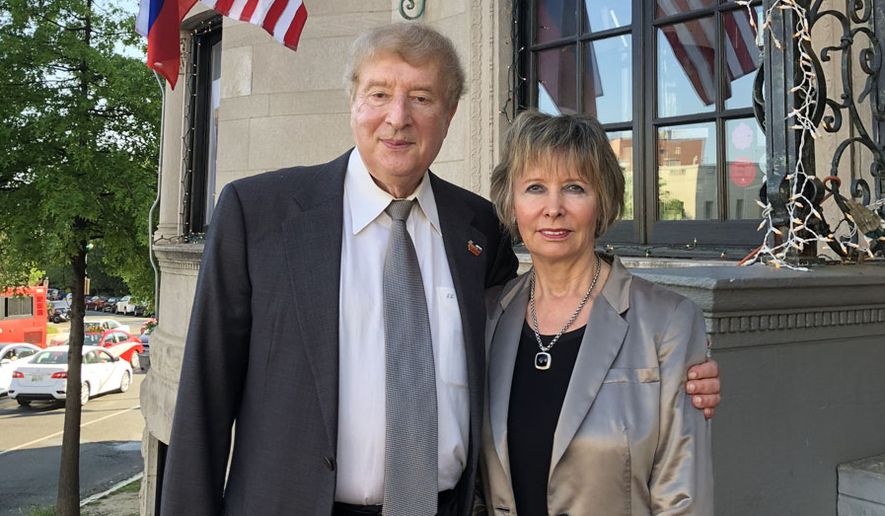1982 was a banner year for Russian physicist Dr. Edward Lozansky and his wife, Tatiana — they and their daughter, Tania, were finally reunited in December 1982 after a grueling 6-year separation enforced by Soviet leaders. The Lozanskys, who are longtime readers of The Washington Times, founded in 1982, work to improve U.S.-Russian relations through Russia House, which they established in 1991. Some thoughts from Dr. Lozansky in honor of 1982 and decades of dialogue:
Q: Why have you been working so long to improve U.S.-Russia relations?
A: Perhaps there is something in my stubborn character that prevents me from been satisfied with the existing state of affairs and forces me to aspire for higher and ambitious goals.
Back in the USSR, I was inspired by the great nuclear scientist Andrei Sakharov, the father of Soviet hydrogen bomb. Despite being highly decorated and enjoying all Kremlin privileges, Sakharov demanded more freedom for his compatriots. He became a human rights campaigner and called for the rapprochement with the West. I was working at the time at the Moscow Institute of Atomic Energy, the equivalent of Los Alamos National Laboratory in New Mexico, and felt that it was my moral duty to do what I could for this cause even though many thought it hopeless. This activity eventually led to my exile and settling in America and becoming a U.S. citizen.
This dream of rapprochement came true in some ways. In the late 1980s, General Secretary Mikhail Gorbachev started radical reforms by declaring a desire to abandon communism and become a part of the West. At that time, my good friend — the late Paul Weyrich of the Free Congress Foundation — and I made several trips to Moscow where we met with top Kremlin decision makers about how America can help. This resulted in a proposal that Paul personally delivered in 1990 to President George H.W. Bush. In it was a detailed road map for Russia’s integration with the West — including joining NATO — while the U.S. would offer Moscow economic assistance during the difficult transition from a planned to a market economy.
As Paul told me afterwards, Mr. Bush listened attentively, and although I cannot tell this for sure perhaps when he talked in 1990 about a “Europe whole and free” and the new “security arch from Vancouver to Vladivostok,” he used the words from this proposal.
Unfortunately, at the end, different wrong decisions were made, like NATO expansion, and the resultant policies dealt a tremendous blow to my dream of Russia becoming a part of the West even when the goal was so close to achievement.
Q: You and your wife Tatiana often travel between these two countries. To some, this is normal and expected, but to others, it is mysterious. Comments?
A: Well, those who know our story — our 6-year battle with the Soviet authorities for reunification — know that we are not giving up easily. Therefore, we continue to fight for yet another “hopeless” case: promoting U.S.-Russia educational, science and cultural ties through the American University in Moscow, which we founded in 1990 with the blessing of Presidents George H.W. Bush and Mikhail Gorbachev.
Q: How would you describe the current state of affairs in U.S.-Russia relations?
A: Worse than at any time since the birth of the U.S. in 1776 when Russia supported the new nation against Britain. Actually, during these 242 years, there were many good moments, including those when we were helping each other and even fighting on the same side. There were bad moments as well, of course, especially during the Cold War, but what we have now is much worse.
Q: What troubles you most about this current state of affairs?
A: In the past, in the times of crisis, American presidents had the full authority to find a compromise. However, Congress has now practically overtaken the president’s authority to negotiate with Moscow. In addition, the mainstream media, which during the Cold War tried to calm down the war-mongering rhetoric, is now pushing to inflame it. The situation is rather pathetic when the Congress and the media, with their miserable approval ratings, work to prevent the president from exercising his constitutional right to conduct the foreign policy.
Q: What gives you hope?
A: Presently, my hope is with President Trump. Tatiana and I are proud that we voted for him as we see that when it comes to U.S.-Russia relations his instincts are right. In my lectures, writings and media appearances, I keep quoting his tweet that only “haters and fools” do not understand that having good relations with Russia is also good for America. Therefore, we continue to support Mr. Trump and have been trying to generate more ideas to find the way out of this megacrisis, which has the potential for the unthinkable military confrontation between the two major nuclear superpowers, if not by design then by accident. We are pleased that despite the resistance of the Washington swamp, Mr. Trump still seeks to have a summit with Russian President Vladimir Putin. If President Ronald Reagan could make a deal with Mr. Gorbachev, why not let Mr. Trump try to do the same with Mr. Putin?
By the way, Americans could be surprised when they find out that there is the statute of Ronald Reagan shaking hands with Mikhail Gorbachev in downtown Moscow. Tatiana and I commissioned this sculpture, as well as the one of Andrei Sakharov, in front of the Russia House on Connecticut Avenue in Washington, D.C. We had the privilege of meeting all these great men, and they give us the hope and inspiration to continue our fight for U.S.-Russia rapprochement.




Please read our comment policy before commenting.